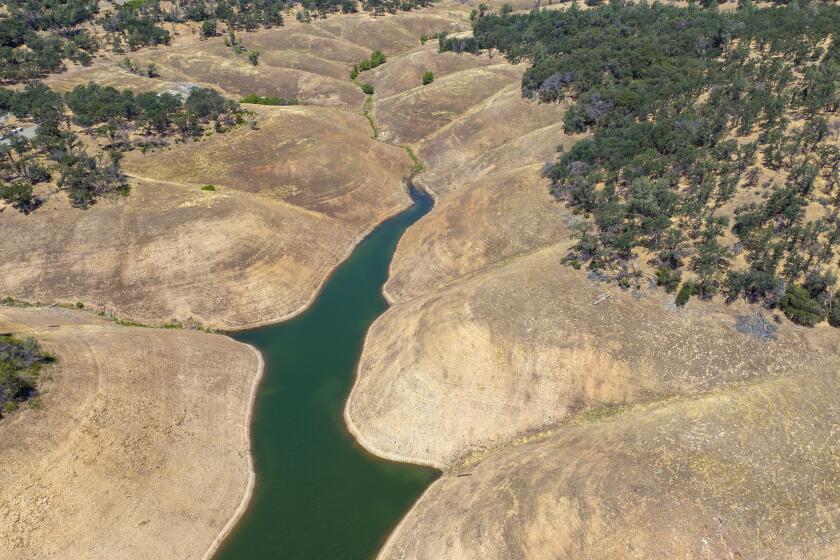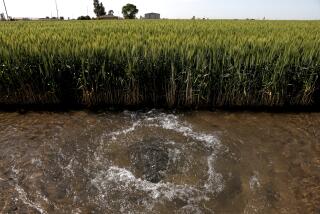
After years of deliberation, California water officials have adopted landmark rules that will guide future water use and conservation in the state.
According to officials, the Making Conservation a California Way of Life framework will help save 500,000 acre-feet of water annually by 2040 — enough to supply more than 1.4 million households for a year — and apply to the state’s largest water utilities, not individuals or households.
Under the new regulations, roughly 400 urban water suppliers will need to meet individualized water-use targets and conservation goals, among other directives. Some agencies will be required to cut water usage by more than 30% within the next 16 years.
The measures are intended to help preserve water supplies as climate change drives hotter, drier conditions. The five-member State Water Resources Control Board voted unanimously Wednesday to adopt the rules, which stem from two 2018 bills that called for the creation of new standards.
“As we think of the Colorado River, the Bay Delta, the stressed watersheds from which much of the urban supply comes into our cities and communities, we need to show — for other states and for ourselves — that we’re taking steps to ease that burden,” chair Joaquin Esquivel said during the board meeting. He added that such efforts are needed “especially in dry times, but through all water year types, in order to ensure that we all continue to have ample supply and thriving communities.”
Aggressive and impactful reporting on climate change, the environment, health and science.
The framework marks a shift from the one-size-fits-all approach that governed California water for years, such as the mandatory 25% statewide water reductions ordered by Gov. Jerry Brown during the 2012-to-‘16 drought. The new rules will instead enable suppliers to weigh local factors such as climate, population and lot size, and to account for previous investments in conservation.
Its approval comes after considerable revisions based on feedback from local water groups — which said the rules would have significant cost implications for some suppliers and customers — and from environmental organizations that said, conversely, that the mandate doesn’t go far enough.
“This regulation will be very challenging — it will require a whole statewide effort to change the way that we use water in California,” said Chelsea Haines, regulatory relations manager with the Assn. of California Water Agencies, which represents about 90% of the state’s city and farm suppliers. “It’s an unprecedented approach, and will require a significant amount of funding and technical support.”
California water regulators have eased requirements for urban water suppliers to meet conservation goals under proposed regulations.
The industry organization was among a coalition of groups that said the rules would create undue burdens for low-income and disadvantaged suppliers. Among other issues, struggling agencies may take in less money from ratepayers once the conservation goals kick in. The majority of the agencies facing the steepest reductions are in inland areas and places that fall below state median household income levels, they said.
The Los Angeles Department of Water and Power, for instance, has already made significant gains in conservation and would not need to achieve its first reduction, 6%, until 2035. Other areas, such as the city of Bakersfield, would need to cut back 25% by 2030 to stay in compliance.
Haines’ concerns echoed a report published by the nonpartisan Legislative Analyst’s Office in January, which slammed an earlier version of the proposal as costly, complicated and unrealistic.
In response to that report and complaints from water agencies, the board decided to relax the conservation requirements. Among other changes, the board reduced the number of suppliers that would have to cut water usage by more than 20% and extended the total timeline for water reductions to 2040 — an addition of five years.
“To do this well and to do this right — and to achieve all of those long-term goals that we really desire as a community — the additional five years that the state water board provided is really important, and I think will help us ultimately achieve a better outcome,” Haines said ahead of Wednesday’s vote.
Drafts of the regulation released in May and June had made other incremental changes, including increasing water allotments for existing residential trees as well as the planting of new-climate-ready trees. Alternative compliance pathways for certain suppliers facing large reductions — including allowing more time to implement plans to meet long-term objectives — were expanded.
Haines said she appreciated the board’s willingness to work with water agencies, but worried that the final regulation still won’t be able to meet all the needs of some smaller suppliers.
“The state water board made important changes to the regulation to help avoid some of these impacts, or provide more flexibility to water suppliers, but there will still be really significant cost impacts to some water suppliers in some communities,” she said. “And unfortunately with the budget now, there isn’t significant financial or technical assistance available.”
Citing global warming, California Gov. Gavin Newsom has unveiled a new water strategy to conserve, capture, recycle and desalinate supplies.
Other groups, however, maintain that the rules are too lax — especially as the state faces a potential 10% decrease in water supplies by 2040, according Gov. Gavin Newsom’s strategy for a hotter, drier future.
“I do think it’s a good framework, but I continue to think that we have far more opportunity across the state to reduce water use and to help prepare our communities for more extremes — more extreme droughts, hotter temperatures, all of the things that we’re already seeing and that are going to get worse,” said Heather Cooley, director of research at the Pacific Institute.
The Pacific Institute was among a coalition of environmental groups that expressed disappointment about the final regulation in a letter to the board. The approved rules, they say, are a watered down version of drafts that set loftier goals and tighter deadlines for conservation measures.
“While this regulation could have been an important tool to proactively manage the state’s urban water supplies, improve California’s climate resilience, and reduce unnecessary water waste, it has instead fallen far short of the goals set by the California Legislature and Governor Newsom’s Water Supply Strategy,” the letter said.
Before the final framework was approved, critics had worried that it would leave wiggle room for backsliding or for agencies that had been meeting regional goals to fall short of individual goals established by the state Legislature. They also expressed concerns about weakened outdoor landscape efficiency standards and uncapped water allowances for land that could potentially be irrigated in the future.
The combination of those issues amounts to 390,000 fewer acre-feet of water conserved by 2030 than in earlier drafts, according to their analysis. (An acre-foot is about 326,000 gallons.)
What’s more, the final regulation means half of the state’s urban water suppliers serving about 72% of Californians do not have to begin reducing water use until 2035 — more than a decade from now.
Cooley said the cost concerns that pertain to smaller and disadvantaged agencies are valid. But she noted that conservation is far less expensive than developing new supplies, particularly as restrictions on groundwater usage and cuts on imported supplies from the Colorado River are expected to kick in soon.
“Less supply will be available in the future, and we’ll have to look at alternatives,” she said. “Conservation and efficiency is the cheapest alternative available to us. It’s not free ... but it’s far less expensive than recycled water, than desalination, than really most other water supply options that we have.”
Citing global warming, California Gov. Gavin Newsom has unveiled a new water strategy to conserve, capture, recycle and desalinate supplies.
During Wednesday’s meeting, board member Laurel Firestone said she too would have liked to have seen an earlier deadline for some agencies. She encouraged the board to continue to engage with stakeholders and work to improve data and reporting practices as the rules roll out.
“I do think these standards are achievable,” Firestone said. “But I do think the key, no matter what, will be the implementation and the learning that we’re doing, particularly over the first couple of years.”
Other provisions in the final regulation include directives for water agencies to identify and pursue opportunities to update residential landscapes as frequently and as soon as possible, since nearly half of the water applied outdoors in cities is lost to wind, evaporation or runoff.
It also directs staff to consider affordability and equity when implementing the rules, including providing assistance to water suppliers that are struggling to meet regulatory obligations, and to develop strategies to support low-income households.
Suppliers who violate the framework could be subject to actions or even fines, but officials said the emphasis will be on progress and compliance. By December 2028, staff must deliver a recommendation to the board about whether to adopt additional policies or guidelines establishing enforcement procedures.
Despite some lingering concerns about the final regulation, board members and experts said it’s ultimately more important to get to work and begin implementation. The rules will go into effect by Jan. 1, 2025.
“This is not a perfect regulation — we can never have a perfect regulation — but it is a significant one,” said Esquivel, the board chair. “And it moves us into a direction here into the future that we can all be proud of, and that is nation-leading. Everyone has a lot to be proud of.”
Times staff writer Ian James contributed to this report.










